What Does ABS Mean on a Car | Safety System Guide
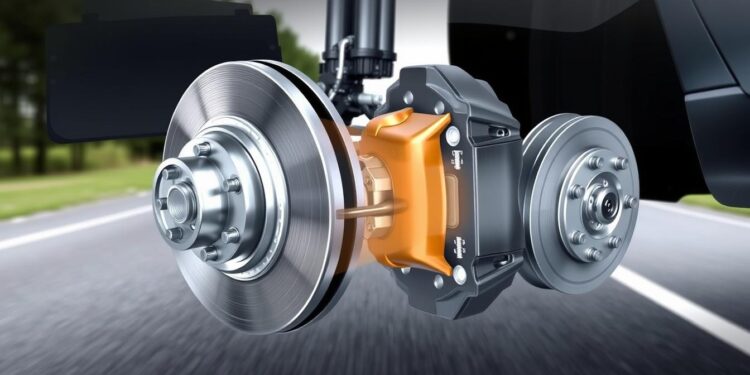
Anti-lock Braking Systems (ABS) have changed car safety a lot. Knowing what ABS means on a car is more than just words. It’s about a key tech that stops wheels from locking up when you brake hard. The government made ABS a must in all new cars by September 1, 2011. This shows how important it is for car insurance and who’s at fault.
Today’s cars have advanced braking systems that help a lot in emergencies. ABS lets drivers keep steering while braking hard. This cuts down skidding and accident risks a lot.
Table of Contents
- 1 Understanding Anti-Lock Braking Systems (ABS)
- 2 What Does ABS Mean on a Car: A Complete Breakdown
- 3 The Core Purpose of Anti-Lock Braking Systems
- 4 Key Components of Modern ABS Systems
- 5 How to Recognize When ABS is Engaged
- 6 Common ABS Warning Light Triggers
- 7 The Relationship Between ABS and Traction Control
- 8 Maintaining Your Vehicle’s ABS System
- 9 Troubleshooting ABS Issues
- 10 ABS Performance in Different Weather Conditions
- 11 The Role of Speed Sensors in ABS Operation
- 12 Impact of ABS on Vehicle Safety Ratings
- 13 When to Service Your ABS System
- 14 Emergency Braking Techniques with ABS
- 15 Conclusion
Key Takeaways
- ABS prevents wheel lock during emergency braking
- Federal regulations require ABS in all new vehicles
- The system enhances steering control during sudden stops
- Most new cars and minivans have 4-wheel ABS
- ABS technology improves overall vehicle safety
Understanding Anti-Lock Braking Systems (ABS)
Anti-Lock Braking Systems are a key safety feature in today’s cars. They help drivers stay safe during sudden stops. This is very important in situations like rental car accidents where quick action is needed.
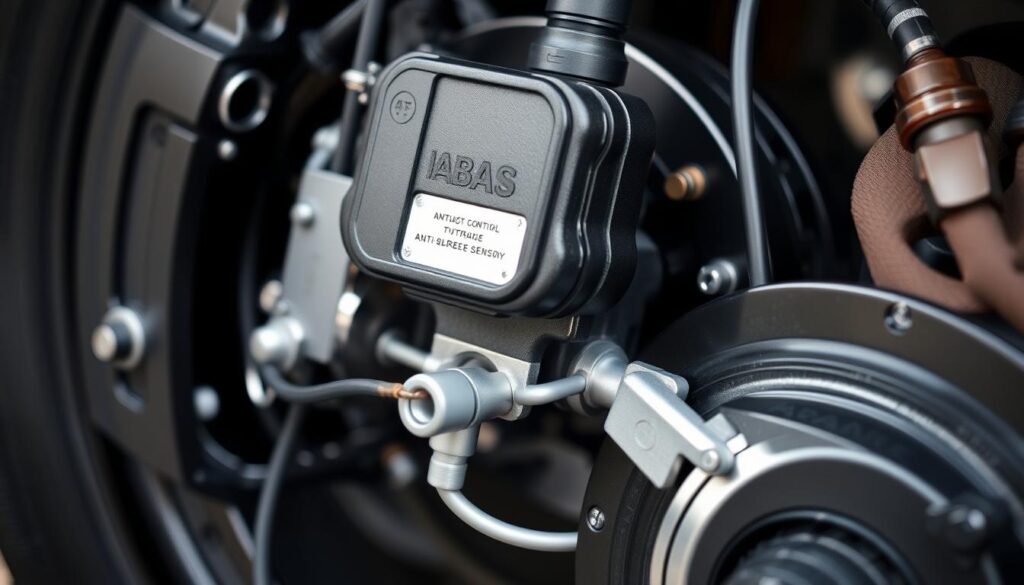
ABS stops wheels from locking up during hard braking. This makes the car more stable and easier to control, no matter the road conditions.
Basic Components of ABS
An ABS system has a few main parts:
- Speed sensors at each wheel
- Hydraulic valves
- Electronic control unit
- Brake pump mechanism
How ABS Technology Works
When you hit the brakes hard, ABS checks the wheel speeds. If a wheel starts to lock, it quickly changes the brake pressure. This can happen up to 15 times per second. It stops the car from skidding and keeps the steering smooth.
“ABS can reduce fatal accidents by approximately 30% in heavy braking situations” – U.S. Department of Transportation
Evolution of Braking Systems
Braking technology has changed a lot. Now, four-channel ABS systems can monitor wheel speeds very well. This makes driving safer, even when you’re not the car’s owner.
ABS is now a must-have in all new cars made after 2012. It has saved millions of drivers from accidents every year.
What Does ABS Mean on a Car: A Complete Breakdown
ABS stands for Anti-Lock Braking System. It’s a key safety feature that stops wheels from locking up during hard braking. This helps keep the car stable and lowers accident risks, mainly in tough driving situations.
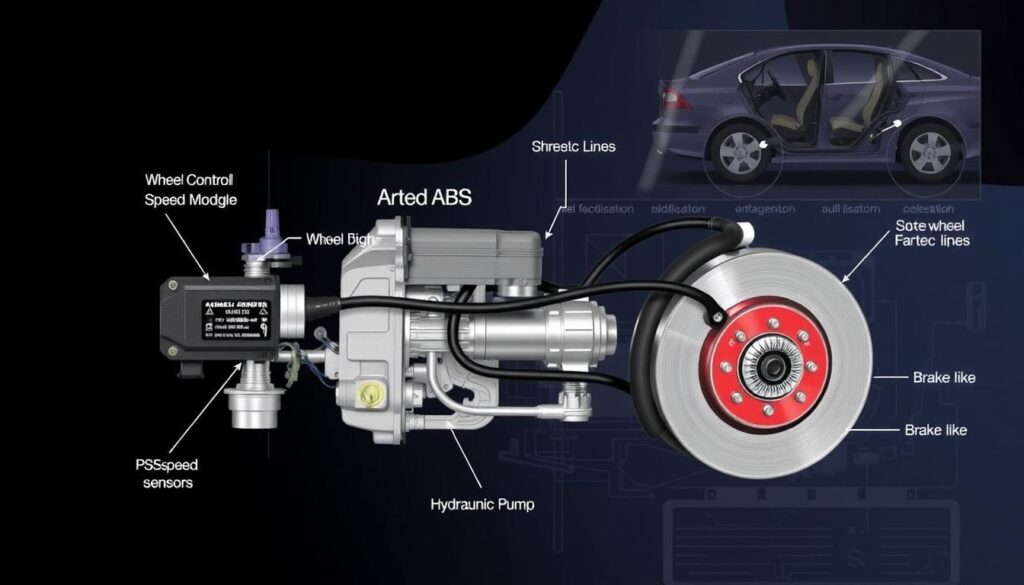
Knowing how ABS works is vital for keeping your car safe. It controls brake pressure quickly to stop wheels from locking up. This is super important in situations like loaner vehicle accidents, where drivers might brake too hard.
- Prevents wheel lock-up during sudden stops
- Maintains steering control in emergency situations
- Reduces the risk of skidding
Vicarious liability is a big deal with ABS. Car owners and makers can face blame if their vehicles lack safety features. Making sure ABS works right can help avoid these issues.
“ABS is not just a feature, it’s a life-saving technology that can prevent accidents.” – Vehicle Safety Expert
Today’s cars have advanced ABS systems. These systems offer many benefits:
| ABS Feature | Safety Impact |
|---|---|
| Wheel Speed Monitoring | Prevents complete wheel lock-up |
| Brake Pressure Modulation | Maintains vehicle stability |
| Emergency Brake Assistance | Reduces collision risk by 26% |
Driving safety depends on understanding and properly using your vehicle’s ABS system. Keeping your ABS in good shape and knowing how it works can greatly improve your driving. It also helps protect you from dangers on the road.
The Core Purpose of Anti-Lock Braking Systems
Anti-lock braking systems (ABS) are a key safety feature in cars. They help drivers stay safe when they need to brake quickly. By stopping wheels from locking up, ABS keeps the car stable and lowers accident risks.

The government made ABS a must-have in all new cars after September 1, 2011. This shows how important it is in preventing accidents.
Preventing Wheel Lock During Braking
ABS stops wheels from locking up during hard braking. It kicks in fast when a driver needs to brake hard. This keeps the car from skidding and helps it stay on course.
- Detects wheel lock-up with speed sensors
- Changes brake pressure automatically
- Allows steering during emergency stops
Maintaining Steering Control
ABS is key in figuring out who’s at fault in accidents. If someone else is driving your car and crashes, ABS helps keep the car stable. It lets drivers steer around obstacles even when braking hard.
Reducing Stopping Distances
ABS makes cars stop faster on most roads. Nearly 90% of new vehicles now have this technology. It helps drivers stop safely and keep control of the car.
“ABS transforms emergency braking from a potentially dangerous situation into a manageable moment of control.” – Automotive Safety Expert
Key Components of Modern ABS Systems
Modern anti-lock braking systems are a complex network of advanced technology. They work together to make vehicles safer. Knowing about these parts helps drivers understand how they prevent wheels from locking up during emergency stops.
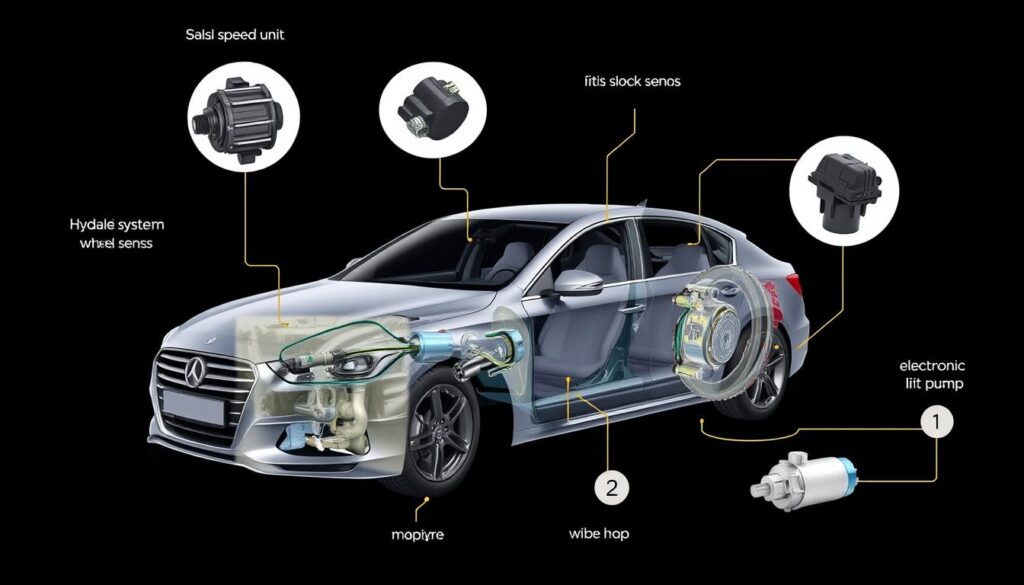
- Wheel Speed Sensors
- Hydraulic Valves
- Electronic Control Unit (ECU)
- Brake Fluid Reservoir
Wheel speed sensors are key in tracking how fast each wheel is turning. They spot when a wheel might lock up during braking. They send this info to the electronic control unit fast.
The ECU can make quick changes to brake pressure over 100 times a second. This is thanks to its fast processing.
“ABS technology can reduce braking distances by up to 20% on dry surfaces, significantly improving vehicle safety.” – Automotive Safety Research Institute
Hydraulic valves control the brakes. They adjust the pressure quickly to stop wheels from locking up. This is important for keeping control of the car, even in emergency stops.
| ABS Component | Primary Function | Performance Impact |
|---|---|---|
| Wheel Speed Sensors | Monitor wheel rotation | Detect possible lock-up |
| Hydraulic Valves | Adjust brake pressure | Stop wheel lock |
| Electronic Control Unit | Handles sensor data | Makes quick braking choices |
The electronic control unit ties everything together. It uses data from wheel speed sensors to decide the best braking plan. Liability coverage often sees ABS as a key safety feature. This can lower insurance costs for cars with ABS.
How to Recognize When ABS is Engaged
Knowing when your Anti-Lock Braking System (ABS) kicks in can boost your confidence when you need to stop fast. It doesn’t matter if you’re driving a rental, a loaner, or your own car. Spotting when ABS is on is key to staying safe on the road.
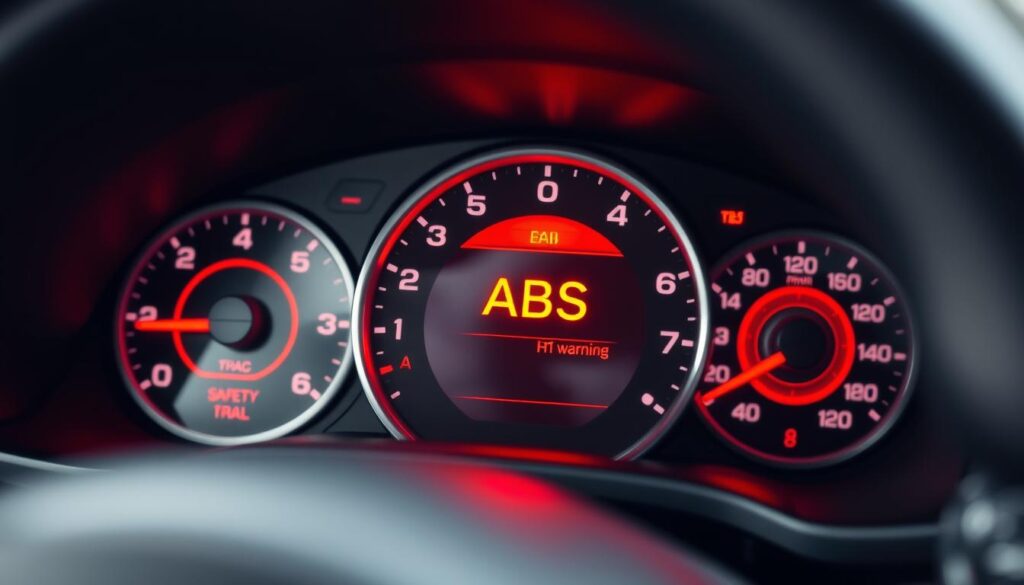
Today’s cars with ABS have clear signs that the system is working. It helps prevent wheels from locking up during sudden stops.
Pedal Pulsation Signals
The first thing you’ll notice is a pulsating feeling in the brake pedal. You might feel:
- Rapid vibration when you press the brakes
- A rhythmic pushback against your foot
- Slight resistance when braking hard
Dashboard Warning Lights
Your dashboard lights up with important info about the ABS. Keep an eye out for:
- The ABS light coming on when you start the car
- A steady light that means there might be a problem
- Both the brake and ABS lights on at the same time, which is a big warning
System Response Indicators
There are more signs of ABS working, like:
- Brief clicking sounds
- Vibrations through the steering wheel
- Less stopping distance on slippery roads
“Recognizing ABS signals can be key during non-owner car insurance claims or rental car accidents”
Remember, these signs are normal. They show the ABS is working to keep your car stable during emergency stops.
Common ABS Warning Light Triggers
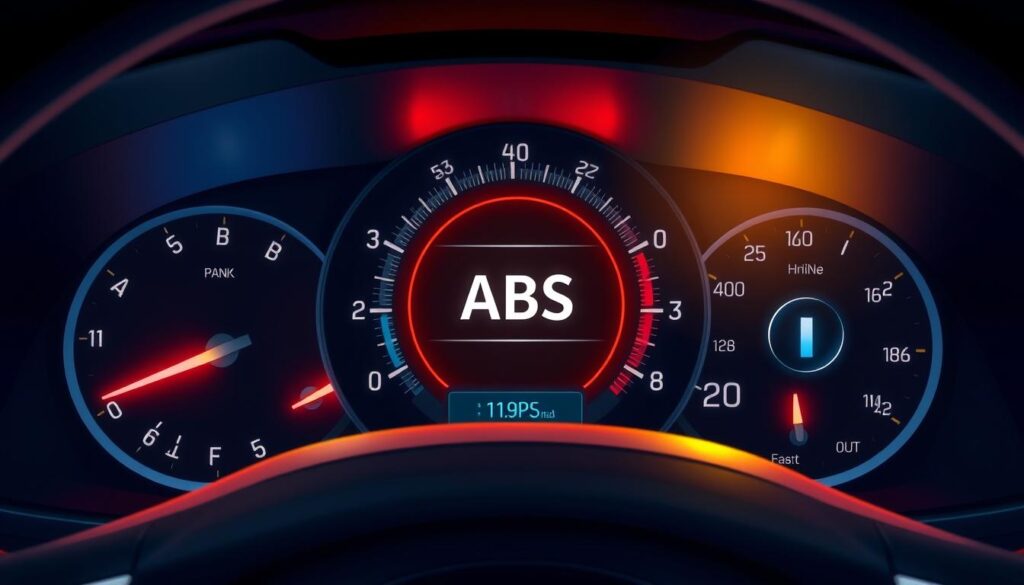
The ABS warning light is a key sign of brake system problems. Drivers should always pay attention to it. Knowing what causes it can help avoid accidents and prevent legal issues.
Vehicle safety depends on many systems, with ABS being key for stopping quickly. If the light comes on, it means there’s a problem that needs fixing right away.
- Malfunctioning ABS Module
- Low Brake Fluid Levels
- Broken Wheel Speed Sensors
- System Deactivation
Wheel speed sensors are very important. Dirt, damage, or electrical problems can affect them. This can turn on the ABS warning light and raise legal concerns for car owners.
| Warning Light Trigger | Potential Impact | Recommended Action |
|---|---|---|
| ABS Module Malfunction | Reduced Brake Control | Professional Diagnostic Check |
| Low Brake Fluid | Compromised Braking Performance | Immediate Fluid Level Inspection |
| Sensor Failure | Inconsistent Wheel Speed Monitoring | Sensor Replacement |
“When the ABS warning light stays on, your vehicle’s safety systems are signaling a possible risk that needs a professional check.”
Modern cars do a self-check when you start the engine. This briefly lights up the ABS light. But if it stays on, it’s a serious problem. It affects your car’s safety and how well it works.
The Relationship Between ABS and Traction Control
Modern car safety systems work together to keep drivers and passengers safe. Traction control and anti-lock braking systems (ABS) are key technologies that help make driving safer.

These advanced safety features share important parts to protect vehicles. Wheel speed sensors are key, watching each wheel’s speed and spotting slip conditions.
- Wheel speed sensors detect rotation variations
- Control modules process sensor information
- Hydraulic brake modulators manage system responses
Integrated Safety Features
Understanding these safety features is vital, like if someone else is driving and gets into an accident. Traction control and ABS work together to stop skidding and keep the car stable in tough driving situations.
“Safety is not an accident, but a deliberate engineering strategy” – Automotive Safety Expert
Car insurance claims often show how these systems could have stopped accidents. A problem with one system can affect the other’s performance.
| System | Primary Function | Key Benefit |
|---|---|---|
| ABS | Prevent wheel lockup | Maintain steering control |
| Traction Control | Limit wheel spin | Improve acceleration stability |
By knowing how these safety systems work together, drivers can see the advanced tech protecting them on the road.
Maintaining Your Vehicle’s ABS System
Keeping your vehicle’s Anti-Lock Braking System (ABS) in good shape is key for safety and performance. If you ignore ABS care, your car might not stop well when you need it to.
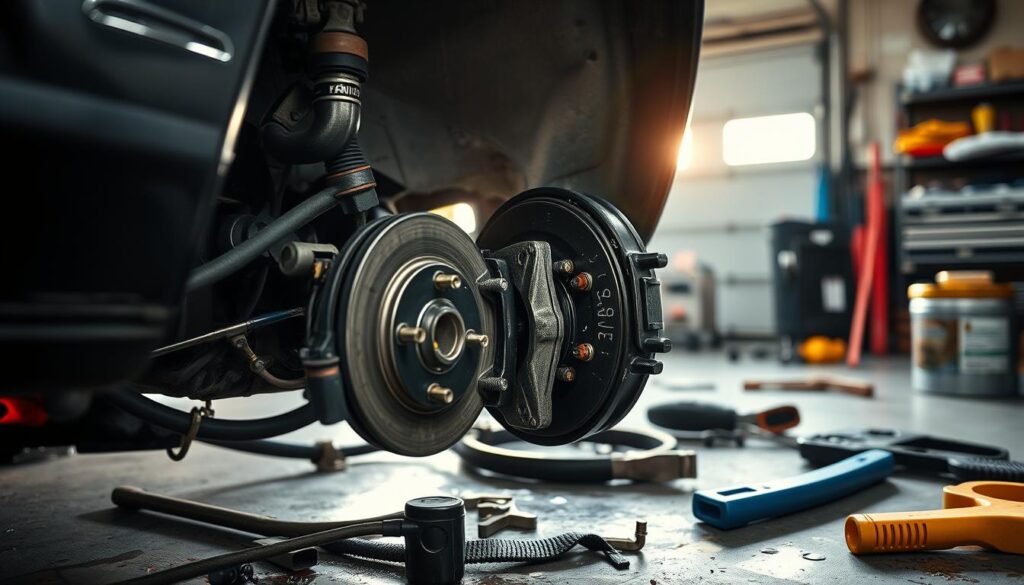
- Check brake fluid levels every three months
- Look at brake pads and rotors every 12,000 miles
- Watch for ABS warning lights right away
- Get a professional to check it every year
“Proactive maintenance can reduce ABS system strain by up to 30%”
ABS sensors are very sensitive. Dirt, moisture, and damage can hurt their work. A pro can find more problems than you can on your own.
| Maintenance Task | Recommended Frequency | Estimated Cost |
|---|---|---|
| Brake Fluid Replacement | Every 2 years or 24,000 miles | $50-$100 |
| Professional ABS Inspection | Annually | $75-$150 |
| Sensor Cleaning | Every 6 months | $25-$50 |
Knowing about liability coverage and non-owner car insurance helps keep your vehicle safe. Policies for permissive use might cover ABS repairs, making regular checks even more important.
By sticking to these maintenance tips, drivers can improve their car’s braking and make ABS parts last longer.
Troubleshooting ABS Issues
Understanding and fixing Anti-Lock Braking System (ABS) problems is key for safety. Whether it’s a rental car or your own vehicle, knowing about ABS issues can stop dangerous driving.
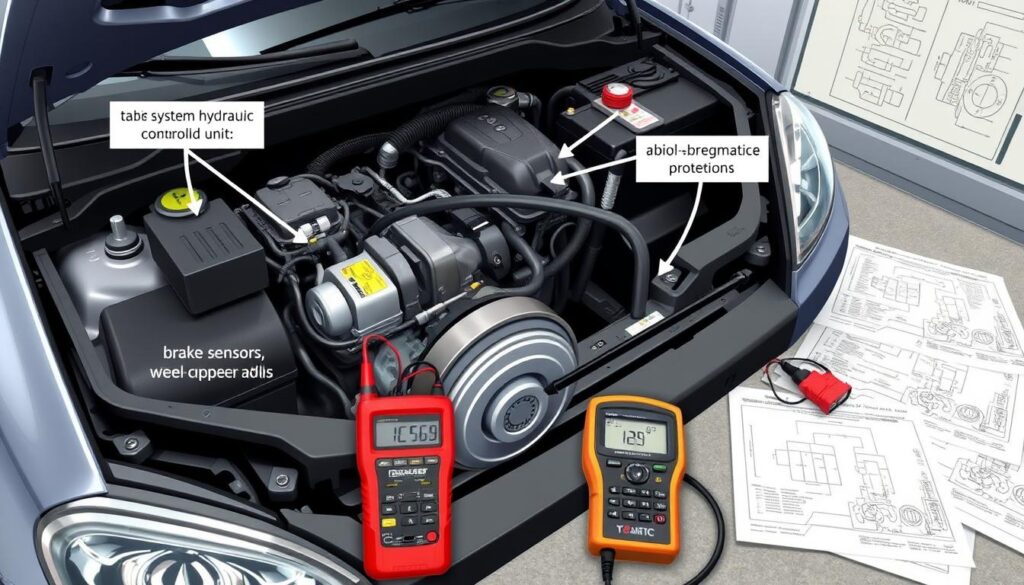
Modern cars have advanced systems to quickly find and fix ABS problems. Drivers should watch for warning signs of system failures.
Diagnostic Procedures
Effective ABS diagnostics include several steps:
- Check the ABS warning light when starting the car
- Use onboard diagnostic tools to read error codes
- Inspect wheel speed sensors for damage
- Check brake fluid levels and condition
Common Problems and Solutions
ABS systems can face many issues that affect safety, like in loaner vehicle accidents or vicarious liability cases.
| Problem | Potential Cause | Recommended Action |
|---|---|---|
| ABS Warning Light | Sensor Malfunction | Professional diagnostic scan |
| Brake Pedal Pulsation | Wheel Speed Sensor Issues | Sensor replacement |
| Reduced Braking Performance | Low Brake Fluid | Fluid level check and refill |
“Proactive maintenance is the key to preventing unexpected ABS system failures.” – Automotive Safety Expert
Regular maintenance and quick action to warning signs can greatly lower brake accident risks. About 20% of ABS malfunctions come from bad speed sensors. So, regular checks are vital for safety.
ABS Performance in Different Weather Conditions

Anti-lock braking systems (ABS) work well in many weather conditions. Knowing how ABS performs in tough weather can make driving safer. This is important for figuring out who’s at fault in accidents or if someone else is driving your car.
Weather affects how well ABS works. Studies show important facts:
- Wet Surfaces: ABS cuts skidding by 50% on wet roads
- Snow and Ice: It helps with steering by about 30%
- Stopping Distances: It shortens stopping times by up to 30% in slippery conditions
Drivers need to know how ABS acts in different weather. This is key when safety systems might not work the same in extreme weather.
| Weather Condition | ABS Performance Improvement | Key Safety Benefit |
|---|---|---|
| Rainy Conditions | 50% Skid Reduction | Enhanced Steering Control |
| Snowy Roads | 30% Stopping Distance Reduction | Maintained Vehicle Stability |
| Icy Surfaces | 25% Improved Braking | Prevented Wheel Lockup |
“ABS transforms challenging driving conditions from dangerous to manageable.” – Automotive Safety Expert
Modern ABS systems adjust to road conditions, giving drivers key safety benefits in different weather. Understanding and anticipating how ABS works can greatly lower accident risks.
The Role of Speed Sensors in ABS Operation
Speed sensors are key parts of a car’s anti-lock braking system (ABS). They act as the car’s eyes and ears, watching wheel rotation closely. This helps prevent accidents and keeps the car running smoothly.
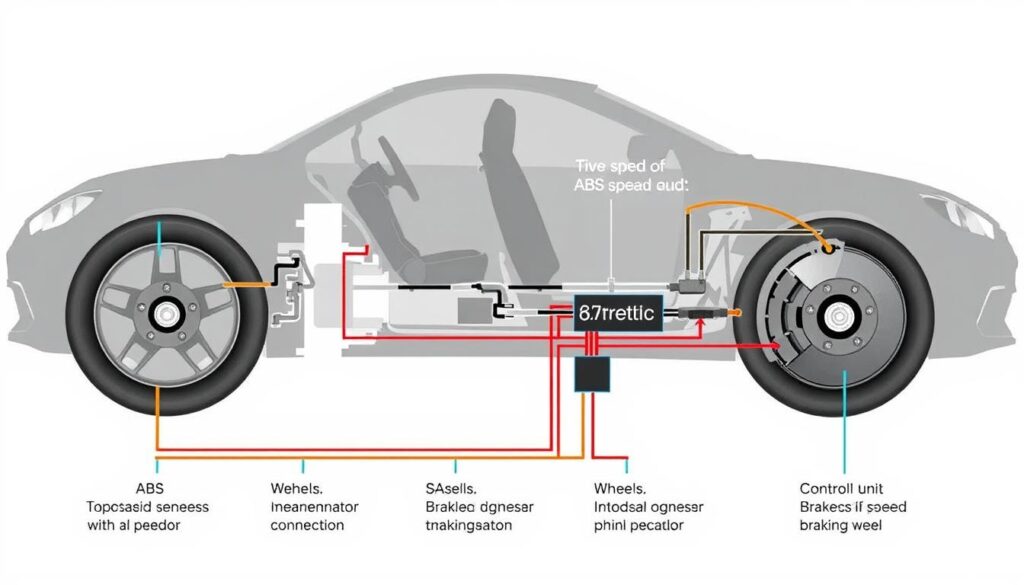
Today, speed sensors are vital for keeping cars safe. They help in making quick decisions during emergency stops. This is important for car insurance claims and who is at fault.
- Detect wheel rotation speed with extreme precision
- Transmit real-time data to the ABS control module
- Prevent wheel lock-up during sudden braking
- Support traction control and stability systems
About 80% of ABS problems come from sensor issues. These sensors last between 50,000 to 100,000 miles. After that, they can start to fail more often.
| Sensor Type | Key Characteristics | Performance |
|---|---|---|
| Active Sensors | Digital signal generation | High precision, low interference |
| Passive Sensors | Analog signal generation | Limited speed range, less accurate |
“Speed sensors are the unsung heroes of vehicle safety, working silently to protect drivers in critical moments.” – Automotive Safety Expert
Knowing how to use these sensors can help keep your car safe. Regular checks and replacing sensors when needed are important. This ensures your ABS works well.
Impact of ABS on Vehicle Safety Ratings
Vehicle safety ratings have evolved with advanced braking tech. Antilock Brake Systems (ABS) are key in a vehicle’s safety, mainly in tough driving situations.
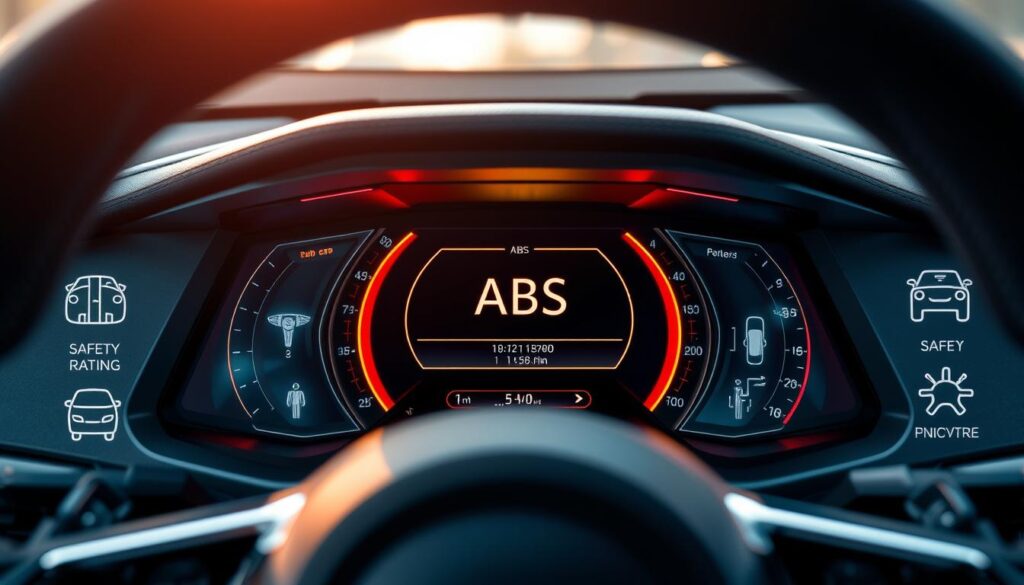
Modern car safety checks highlight ABS’s role in avoiding crashes. Starting in 2013, ABS became a must for all U.S. passenger cars. This shows how vital ABS is in safety standards.
Safety Standards and Performance Metrics
Today, safety ratings look closely at braking systems. The National Highway Traffic Safety Administration (NHTSA) sets strict standards. These standards test ABS in different conditions, like:
- Wet road conditions
- Emergency braking situations
- Steering control during hard braking
- Crash prevention capabilities
Testing Procedures for ABS Effectiveness
Tests are done to check how well ABS works. Studies show big safety gains with ABS:
| Safety Metric | ABS Impact |
|---|---|
| Crash Rate Reduction | Up to 35% |
| Fatal Crash Reduction | 29% fewer incidents |
| Stopping Distance Improvement | 10-20% reduction |
For non-owner car insurance and rental car accidents, ABS adds safety. It also helps reduce loaner vehicle accidents with its advanced braking.
“ABS represents a critical advancement in automotive safety, transforming how vehicles respond during emergency braking scenarios.” – NHTSA Safety Report
ABS is a key part in getting high safety ratings. It keeps drivers and passengers safe in many driving situations.
When to Service Your ABS System
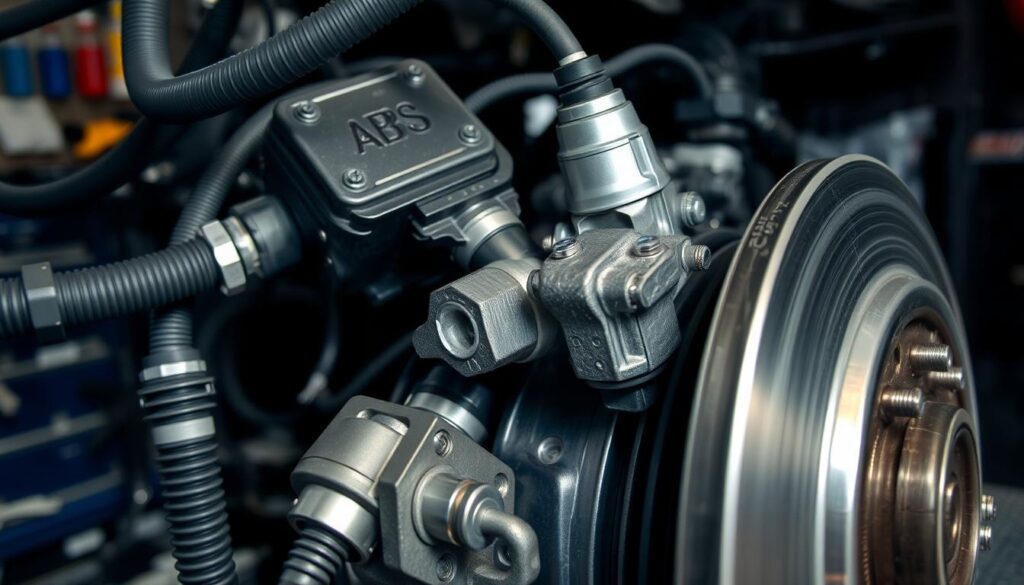
Keeping your vehicle’s Anti-Lock Braking System (ABS) in good shape is key for safety. If brakes don’t work right, it can cause big problems on the road.
Vehicle owners should watch for signs that your ABS needs service:
- ABS warning light illumination
- Unusual brake pedal vibration
- Reduced braking performance
- Inconsistent wheel speed sensor readings
Research shows why ABS maintenance is important:
- About 10-15% of vehicles have ABS problems at any time
- 30% of drivers ignore warning lights, risking safety
- 40% of drivers wait too long to get help when the ABS light comes on
“Timely ABS system maintenance can reduce the risk of brake-related accidents by up to 35%”
Who’s at fault in accidents often depends on vehicle maintenance records. Regular checks can avoid legal trouble by keeping brakes working well.
Here are some service tips:
- Get a brake system check every year
- Check brake fluid every 6 months
- Replace wheel speed sensors every 50,000 miles
- Don’t ignore ABS warning lights
By focusing on ABS maintenance, drivers can make their vehicles safer. They also avoid expensive fixes and legal issues from brake failures.
Emergency Braking Techniques with ABS
Learning how to use Anti-Lock Braking Systems (ABS) is key for safety. If someone else is driving your car and has an accident, knowing how to brake right can help avoid big problems.

ABS makes stopping in emergencies better by stopping wheels from locking up. Drivers should use certain methods to stay safe when they need to stop fast:
- Apply firm, constant pressure to the brake pedal
- Avoid pumping the brakes, which reduces ABS effectiveness
- Maintain steering control while braking hard
- Expect pedal pulsation as ABS engages
ABS is very effective in emergency stops:
| Performance Metric | Improvement |
|---|---|
| Stopping Distance Reduction | 10-30% on various road conditions |
| Fatal Crash Reduction | 30% fewer incidents |
| Steering Control Maintenance | Crucial in 85% of emergency scenarios |
Knowing how ABS works can help with car insurance claims after an accident. Using emergency braking techniques right can lessen the impact of a crash and show you were driving carefully.
ABS sensors send signals between 20-200 Hz, making quick braking changes in urgent times.
Getting used to ABS can make drivers feel more confident and safe on the road, even when things are unexpected.
Conclusion
Anti-lock Braking Systems (ABS) are a big step forward in car safety. Studies show that cars with ABS have 30% fewer fatal crashes. This makes ABS a must-have for drivers looking for safety on the road.
Knowing how ABS works is more than just tech talk. It can cut stopping times by up to 30% on wet roads. This is key for avoiding accidents and keeping drivers safe. ABS adjusts brake pressure 20 times a second, helping drivers stay in control.
Keeping your ABS in top shape is important. Even though 70% of drivers don’t know what ABS warning lights mean, knowing them can save your car. Drivers need to know how to use their car’s safety features and act fast when they see warning signs.
ABS saves about 5,000 lives every year in the U.S. It stops wheels from locking up, keeps steering control, and lowers crash risks. This makes ABS a vital part of car safety today.






